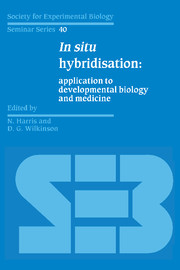Book contents
- Frontmatter
- Contents
- List of contributors
- Preface
- Non-radioisotopic labels for in situ hybridisation histochemistry: a histochemist's view.
- Use of haptenised nucleic acid probes in fluorescent in situ hybridisation
- The use of complementary RNA probes for the identification and localisation of peptide messenger RNA in the diffuse neuroendocrine system
- Contributions of the spatial analysis of gene expression to the study of sea urchin development
- Advantages and limitations of in situ hybridisation as exemplified by the molecular genetic analysis of Drosophila development
- The use of in situ hybridisation to study the localisation of maternal mRNAs during Xenopus oogenesis
- In situ hybridisation in the analysis of genes with potential roles in mouse embryogenesis
- Evolution of algal plastids from eukaryotic endosymbionts
- Localisation of expression of male flower-specific genes from maize by in situ hybridisation
- Tissue preparation techniques for in situ hybridisation studies of storage-protein gene expression during pea seed development
- Investigation of gene expression during plant gametogenesis by in situ hybridisation
- Sexing the human conceptus by in situ hybridisation
- Non-isotopic in situ hybridisation in human pathology
- The demonstration of viral DNA in human tissues by in situ DNA hybridisation
- Index
Non-radioisotopic labels for in situ hybridisation histochemistry: a histochemist's view.
Published online by Cambridge University Press: 04 August 2010
- Frontmatter
- Contents
- List of contributors
- Preface
- Non-radioisotopic labels for in situ hybridisation histochemistry: a histochemist's view.
- Use of haptenised nucleic acid probes in fluorescent in situ hybridisation
- The use of complementary RNA probes for the identification and localisation of peptide messenger RNA in the diffuse neuroendocrine system
- Contributions of the spatial analysis of gene expression to the study of sea urchin development
- Advantages and limitations of in situ hybridisation as exemplified by the molecular genetic analysis of Drosophila development
- The use of in situ hybridisation to study the localisation of maternal mRNAs during Xenopus oogenesis
- In situ hybridisation in the analysis of genes with potential roles in mouse embryogenesis
- Evolution of algal plastids from eukaryotic endosymbionts
- Localisation of expression of male flower-specific genes from maize by in situ hybridisation
- Tissue preparation techniques for in situ hybridisation studies of storage-protein gene expression during pea seed development
- Investigation of gene expression during plant gametogenesis by in situ hybridisation
- Sexing the human conceptus by in situ hybridisation
- Non-isotopic in situ hybridisation in human pathology
- The demonstration of viral DNA in human tissues by in situ DNA hybridisation
- Index
Summary
Introduction
The early development of in situ hybridisation relied heavily upon the use of radioisotopes and autoradiography for the visualisation of specifically hybridised gene probes (Buongiorno-Nardelli & Amaldi, 1969; Gall & Pardue, 1969, 1971). Radioisotopic labelling retains an important role, especially where maximum sensitivity is required, but in recent years a group of techniques employing non-radioisotopic labelling technology have been developed. They have been designed to avoid the perceived drawbacks of radiolabels in terms of safety and inconvenience.
In this review I hope to provide a flavour of the range of non-isotopic techniques available, to discuss their relative merits and to divine future developments. Some general methodologies are outlined but these must be considered as general guidelines from which optimal protocols must be individually determined (some detailed protocols are provided in later chapters).
Aim
In situ hybridisation identifies specific DNA or RNA sequences in tissue sections. What questions can in situ hybridisation answer that other methods cannot?
Standard molecular biological methods using gel electrophoretic separation of restriction fragments is ideal for characterising genomes, for viral detection or general changes in gene expression. However, in certain respects these methods have severe limitations. Extremely small quantities of nucleic acid can be detected by filter hybridisation but the identity of the cell containing the target sequence is unknown. Therefore electrophoretic separation methods provide no distributional information but are rather an accurate measure of the average nucleic acid content of a tissue homogenate. Only in situ hybridisation provides the capacity for the identification of specific target sequences within a mixed cell population. This depends upon the presence of localised areas of high target sequence concentration within a background of non-homologous sequences.
- Type
- Chapter
- Information
- In Situ HybridisationApplication to Developmental Biology and Medicine, pp. 1 - 32Publisher: Cambridge University PressPrint publication year: 1990
- 4
- Cited by



